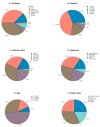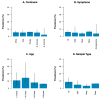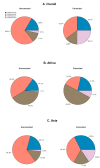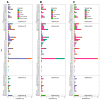World-Wide Prevalence and Genotype Distribution of Enteroviruses
- PMID: 33800518
- PMCID: PMC7999254
- DOI: 10.3390/v13030434
World-Wide Prevalence and Genotype Distribution of Enteroviruses
Abstract
Enteroviruses (EVs) are highly prevalent viruses world-wide, causing a wide range of diseases in both children and adults. Insight in the global prevalence of EVs is important to define their clinical significance and total disease burden, and assists in making therapeutic decisions. While many studies have been conducted to describe epidemiology of EVs in specific (sub)populations and patient cohorts, little effort has been made to aggregate the available evidence. In the current study, we conducted a search in the PubMed and Embase (Ovid) databases to identify articles reporting EV prevalence and type distribution. We summarized the findings of 153 included studies. We found that EVs are highly prevalent viruses in all continents. Enterovirus B was the most detected species worldwide, while the other species showed continent-specific differences, with Enterovirus C more detected in Africa and Enterovirus A more detected in Asia. Echovirus 30 was by far the most detected type, especially in studies conducted in Europe. EV types in species Enterovirus B-including echovirus 30-were often detected in patient groups with neurological infections and in cerebrospinal fluid, while Enterovirus C types were often found in stool samples.
Keywords: enterovirus; epidemiology; genotype; prevalence.
Conflict of interest statement
The authors declare no conflict of interest.
Figures






References
-
- Picornaviridae. [(accessed on 1 June 2020)]; Available online: www.picornaviridae.com.
-
- Khetsuriani N., Lamonte-Fowlkes A., Oberst S., Pallansch M.A., Centers for Disease Control and Prevention Enterovirus surveillance—United States, 1970–2005. MMWR Surveill. Summ. 2006;55:1–20. - PubMed
-
- Janes V.A., Minnaar R., Koen G., van Eijk H., Dijkman-de Haan K., Pajkrt D., Wolthers K.C., Benschop K.S. Presence of human non-polio enterovirus and parechovirus genotypes in an Amsterdam hospital in 2007 to 2011 compared to national and international published surveillance data: A comprehensive review. EuroSurveillance. 2014;19:20964. doi: 10.2807/1560-7917.ES2014.19.46.20964. - DOI - PubMed
-
- Bubba L., Broberg E.K., Jasir A., Simmonds P., Harvala H. Enterovirus Study Collaborators. Circulation of non-polio enteroviruses in 24 EU and EEA countries between 2015 and 2017: A retrospective surveillance study. Lancet Infect. Dis. 2020;20:350–361. doi: 10.1016/S1473-3099(19)30566-3. - DOI - PubMed
Publication types
MeSH terms
Substances
LinkOut - more resources
Full Text Sources
Other Literature Sources
Medical

